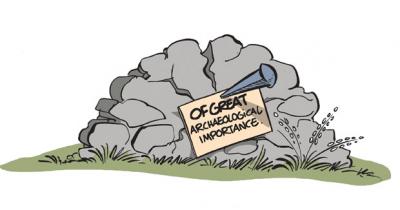Throughout the 19th century, there was much speculation about the ruins at Vieux Grand Port. In fact, in 1895, L.H. de Froberville surveyed the site and in his report to the Comité des Souvenirs Historiques stated that the remains were of an 18th century structure, thereby reinforcing the doubts whether these ruins did bear testimony as to the occupation of the site by the Dutch.
From the early 20th century, as research was coming through the sequence occupance of this site unravelled its mystery. From the late 16th century Dutch East India Company ships were using the island as a refreshment station. In 1637, the Company’s directors decided to establish a permanent settlement. Opperhoofd (Commander) Cornelis Gooyer with a crew of 25 men set up a small four-pointed star fort made up of wooden palisades and earthen ramparts. The main building or lodge was made of wood. Gooyer caused the Fort Frederik Hendrik to be built on the colluvial deposits at the base of Lion Mountain. A rivulet-Fosse Hollandaise-crosses this 7m high site ; it protected the site from excessive overflow and provided a regular water supply.
During the first Dutch occupation, the fort was destroyed several times by cyclones and fires till its abandonment in 1658. The second period of Dutch occupation which lasted from 1664 to 1710 was marked by the arrival of freemen who settled as farmers. The 1695 cyclone severely affected the wooden structures and opperhoofd Deodati had a new stone lodge built in 1698. Up to the final withdrawal of the Dutch, the fort had to weather several cyclones, fires and maroon attacks. At their departure, the Dutch burned the whole site ; leaving only the stone lodge standing. The Dutch lodge was used by the French colonial authorities from 1721 to 1741. In 1753 it was pulled down making way for a French government complex-today’s ruins (1).
All these had to be substantiated by archaeological research to unearth indisputable archaeological evidence of Dutch presence. It was only in 1973 that Paul van Vliet, a representative of the Dutch foundation for the Cultural History of Dutch Overseas, investigated the site. He concluded that the ruins were not of Dutch origin but French. He did some excavations and recovered 18th century artefacts such as a French bayonet, iron nails and pieces of pottery.
Following the international conference on coastal fortifications in 1996 and the newly formed Mauritius Museums Council (MMC) in 2000, systematic archeological research was initiated with the help of University of Amsterdam and the American Rutgers University. The excavation was carried during five seasons from 1999-2000 and 2003-05. A substantial number of artefacts were uncovered-most of these form the present day collection of the museum on site. The most important finding was the stone Dutch wall of the lodge. The Dutch archaeologists suggested that this wall should be covered to protect it from the tropical weather and photographs be displayed to show the existence of the stone wall. Members of then board of the MMC opted for a display board to be placed well away from the exposed stone wall. It seems that this decision of the 2004 board has been reversed as now there is a marble plaque which has been cemented on part of the wall denoting Dutch ruins.
The question which is bothering some of my Dutch friends – is this the right way to protect this archaeological evidence of our past ?
DUTCH FORT FREDERIK HENDRIK – VIEUX GRAND PORT: Protecting archaeological evidence
- Publicité -
EN CONTINU ↻



